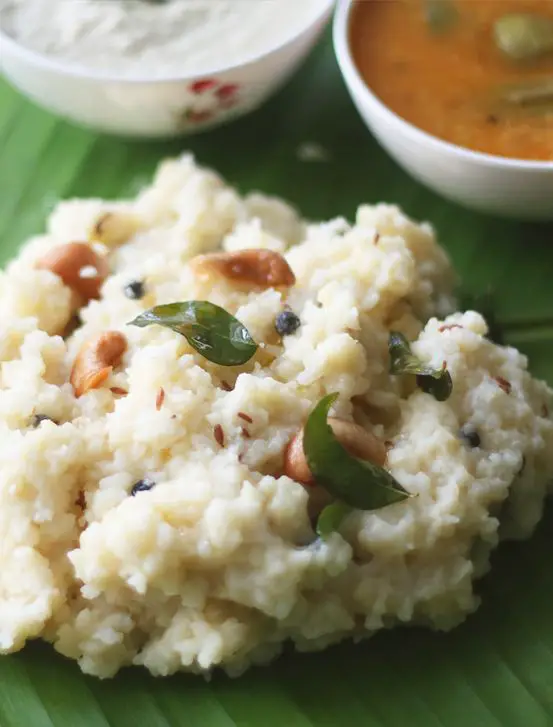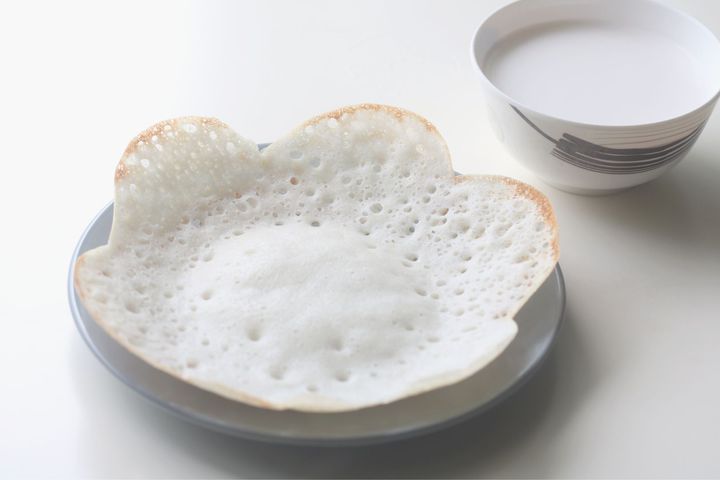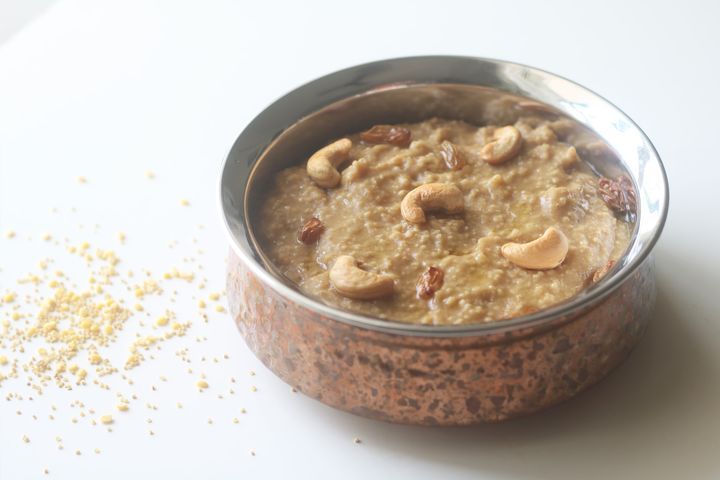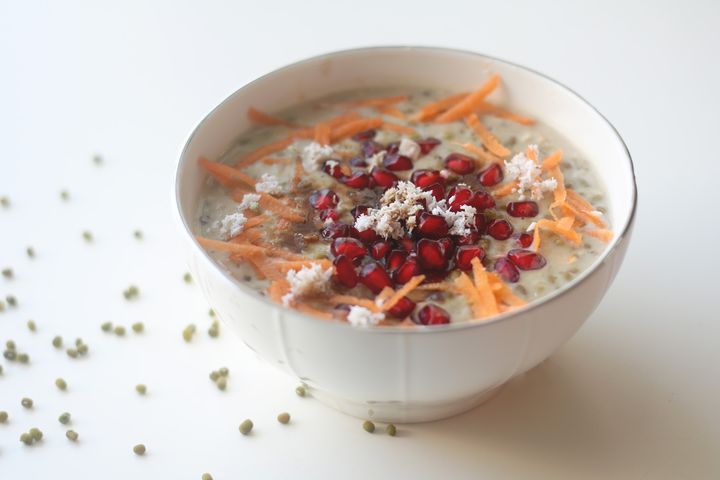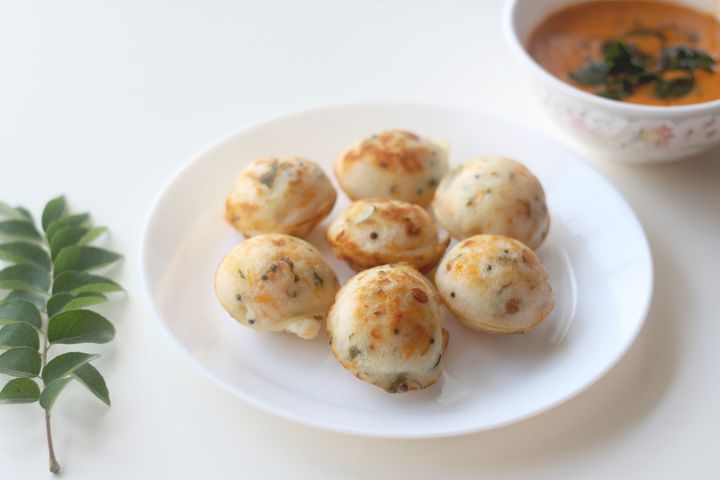Ven Pongal
Ven Pongal is a traditional as well a popular South Indian breakfast, during the Pongal festival. Ven Pongal is also called as Kara Pongal.

Ven Pongal is a traditional as well a popular South Indian breakfast, during the Pongal festival. Ven Pongal is also called as Kara Pongal. It is a comfort – food as it is easy and fast to prepare. It is light to the stomach and at the same time, very nutritious. So friends, try this out and let me know it came! Happy Pongal!
In this article, we will be diving into the delicious and comforting dish known as ven pongal. This South Indian delicacy is made with a combination of rice and moong dal, and is infused with fragrant spices and ghee. Known for its simplicity and hearty flavors, ven pongal is a popular breakfast or brunch item that is often enjoyed with sambar or coconut chutney. Let's explore the unique and delightful recipe for ven pongal.
What Is Ven Pongal?
- Ven Pongal is a traditional South Indian dish made with a delicious combination of raw rice, moong dal, and a variety of Indian spices. The dish is seasoned with a unique tempering of ghee, black peppercorns, cumin seeds, grated ginger, curry leaves, and asafoetida, which enhances its aroma and flavor.
- This savory and succulent dish is commonly served hot with sambar or coconut chutney, making it a popular choice for breakfast or lunch in many South Indian households.
Why You'll Love Ven Pongal?
- Creamy Texture: Ven Pongal has a delightful creamy texture that comes from the combination of rice and moong dal, making it a comforting and satisfying dish.
- High Protein: Moong dal is a rich source of protein, making Ven Pongal a nutritious and filling meal option.
- Gut-Friendly: The use of moong dal in Ven Pongal makes it easy to digest and gentle on the stomach, making it a great choice for those with digestive issues.
- Balanced Flavor: The combination of spices like black pepper, cumin seeds, and ginger in the tempering, adds a depth of flavor and aroma to the dish.
- Heart Healthy: The tempering of Ven Pongal with ghee and cashews adds healthy fats, which are beneficial for heart health.
- Versatile: Ven Pongal can be enjoyed on its own or paired with sambar or coconut chutney, making it a versatile dish for any meal of the day.

Ingredients for Ven Pongal
- Raw rice: Adds a fluffy texture and acts as the base for the dish.
- Moong dal / Pasi paruppu: Enhances the nutritional value and adds a creamy texture to the pongal.
- Ghee: Adds a rich and aromatic flavor to the dish, and helps in tempering the spices.
- Whole black pepper corns: Brings a spicy and warm flavor to the pongal.
- Cumin seeds: Adds a nutty and earthy flavor to the dish.
- Asafoetida: Enhances the overall aroma and flavor of the ven pongal.
How To Make Ven Pongal?
- Making ven pongal is a simple and delicious process that will leave your taste buds satisfied. To start, wash the rice and dal together a couple of times with water and drain very well, then roast them until a nice aroma comes. Next, pressure cook the rice and dal, and then mash them well.
- Once the rice and dal are cooking, prepare the tempering by frying peppercorns, cumin seeds, grated ginger, curry leaves, and cashews in ghee. Then, pour the tempering into the mashed rice and dal mixture and mix well to combine. Let it sit covered for 5 minutes to allow the flavors to infuse, and then it's ready to be served hot with sambar or coconut chutney.
- The key step in making ven pongal is to ensure that the tempering is done with care and patience, as it significantly enhances the flavor and aroma of the dish. By following these steps, you can create a delicious and aromatic ven pongal that will be enjoyed by all.
Serving Suggestions
- Pair with Sambar: Ven pongal pairs perfectly with a delicious and tangy sambar. The combination of the creamy pongal and the spicy-sour sambar is sure to satisfy your taste buds.
- Serve with Coconut Chutney: Another fantastic pairing for ven pongal is coconut chutney. The cool and refreshing chutney balances out the rich flavors of the pongal, creating a well-rounded meal.
- Add a Side of Pickle: For an extra kick of flavor, consider serving ven pongal with a side of your favorite pickle. The spiciness of the pickle adds an extra dimension to the dish.
- Enjoy with a Side Salad: A light and fresh side salad can also complement the comforting flavors of ven pongal. Consider a simple cucumber or tomato salad for a healthy and refreshing addition to your meal.
- Accompany with Pappadum: Crispy and crunchy pappadum is a great accompaniment to ven pongal. The texture contrast of the pappadum adds an enjoyable element to the meal.
By offering these serving suggestions, you can elevate the dining experience and create a well-rounded meal with ven pongal as the star.
Tips for Making Ven Pongal
- Preparation Duration: It is essential to wash the rice and dal thoroughly to remove any impurities and drain them well before cooking. This helps to ensure that the ven pongal turns out fluffy and not sticky.
- Cooking Techniques: Roasting the rice and dal until a nice aroma comes, and pressure cooking it for 4 whistles, ensures that the ven pongal is cooked to perfection. This step also helps to blend the flavors of the rice and dal together.
- Importance of Garnishing: Garnishing the ven pongal with a tempering of ghee, cashews, peppercorns, and other spices not only adds flavor but also enhances the presentation of the dish. The golden brown cashews and spluttering peppercorns add a beautiful touch to the final dish.
- Enhancing the Aroma: Covering the ven pongal with a lid after adding the tempering and letting it sit for 5 minutes allows the flavors to infuse, enhancing the overall aroma of the dish.
- Serving Suggestions: Ven pongal is best served hot with sambar or coconut chutney. The combination of these side dishes elevates the flavors of the ven pongal and makes for a satisfying meal.
- Experimenting with Flavors: Feel free to experiment with different spices and herbs while making ven pongal to customize the flavors according to your preference. Adding a touch of your favorite spices can make the dish even more delightful.
Variations for Ven Pongal
- Vegetable Pongal: For a healthier twist, add finely chopped vegetables like carrots, peas, and beans to the rice and dal mixture before pressure cooking. This adds a pop of color and extra nutrients to the dish.
- Coconut Pongal: Replace the ghee with coconut oil for a subtle coconut flavor. You can also add a handful of freshly grated coconut to the tempering for an added tropical twist.
- Spicy Pongal: Increase the amount of black pepper and add a pinch of red chili powder to the tempering for a spicier kick. This variation is perfect for those who enjoy a little heat in their dishes.
- Lentil Pongal: Swap the moong dal with other lentils like masoor dal or toor dal for a different texture and taste. Each lentil brings its own unique flavor to the dish.
- Millet Pongal: Replace the raw rice with millet such as foxtail millet or barnyard millet for a healthier, gluten-free version of ven pongal. It's a great way to switch up the grains and add variety to your diet.
- Nutty Pongal: Experiment with different nuts such as almonds, pistachios, or even peanuts in place of cashews for a different nutty flavor and crunch in every bite. This adds a delightful texture to the dish.
Get creative with these variations and make the traditional ven pongal your own! Each variation adds a unique twist to the classic recipe, giving you the opportunity to customize it according to your preferences. Enjoy exploring and experimenting with different ingredients to create a memorable dining experience.
How to Store Ven Pongal
- Storing the Rice and Dal Mixture: After cooking the rice and dal, allow it to cool down to room temperature. Once cooled, transfer the ven pongal to an airtight container and store it in the refrigerator. This will help maintain its freshness and prevent it from spoiling.
- Properly Storing the Tempering: The tempering plays a crucial role in enhancing the flavor of the ven pongal. After making the tempering, store it in a separate airtight container and keep it at room temperature. This will ensure that the flavors remain intact and do not lose their potency.
- Utilizing Fresh Ingredients: It's important to use fresh and high-quality ingredients when making ven pongal. This includes using fresh spices, ghee, and cashews. Properly storing these ingredients in a cool, dark place will help maintain their freshness and flavor, resulting in a delicious batch of ven pongal every time.
- Keeping Moisture at Bay: Moisture can affect the texture and taste of ven pongal. To prevent moisture from seeping into the stored ven pongal, ensure that the airtight containers are completely dry before transferring the dish into them. This will help maintain the texture and flavor of the dish.
- Avoiding Temperature Fluctuations: Fluctuations in temperature can lead to spoilage and loss of flavor in ven pongal. Store the dish in the coldest part of the refrigerator to maintain its freshness and delicious taste for a longer period.
- Reheating Tips: When reheating ven pongal, ensure that it is heated thoroughly to kill any potential bacteria. You can reheat it in the microwave or on the stovetop, adding a little water to retain its creamy texture.
By following these storage tips, you can enjoy freshly made ven pongal for longer periods without compromising its taste and quality.
Frequently Asked Questions (FAQs)
How can I adjust the spice level of ven pongal?
- If you prefer a milder flavor, you can reduce the amount of black pepper corns and cumin seeds used in the tempering. You can also adjust the amount of grated ginger to suit your taste.
Can I use brown rice instead of raw rice for making ven pongal?
- Yes, you can substitute brown rice for raw rice. Keep in mind that the cooking time may vary, so adjust the pressure cooking time as needed.
What can I serve with ven pongal besides sambar or coconut chutney?
- Ven pongal can also be served with tomato chutney, mint chutney, or even a side of roasted papad for a different flavor experience.
Can I make ven pongal ahead of time and reheat it?
- Yes, you can prepare ven pongal ahead of time and reheat it before serving. Just add a little water when reheating to prevent it from becoming too dry.
How do I store leftover ven pongal?
- Store leftover ven pongal in an airtight container in the refrigerator for up to 2 days. When reheating, add a little water to restore the creamy texture.
Can I add vegetables to ven pongal for added nutrition?
- Yes, you can add finely chopped vegetables like carrots, peas, or beans to the rice and dal mixture before pressure cooking for a nutritious twist. Adjust the cooking time accordingly to ensure the vegetables are cooked through.
Recipe Card
Ven Pongal 2018-05-18 01:46:35
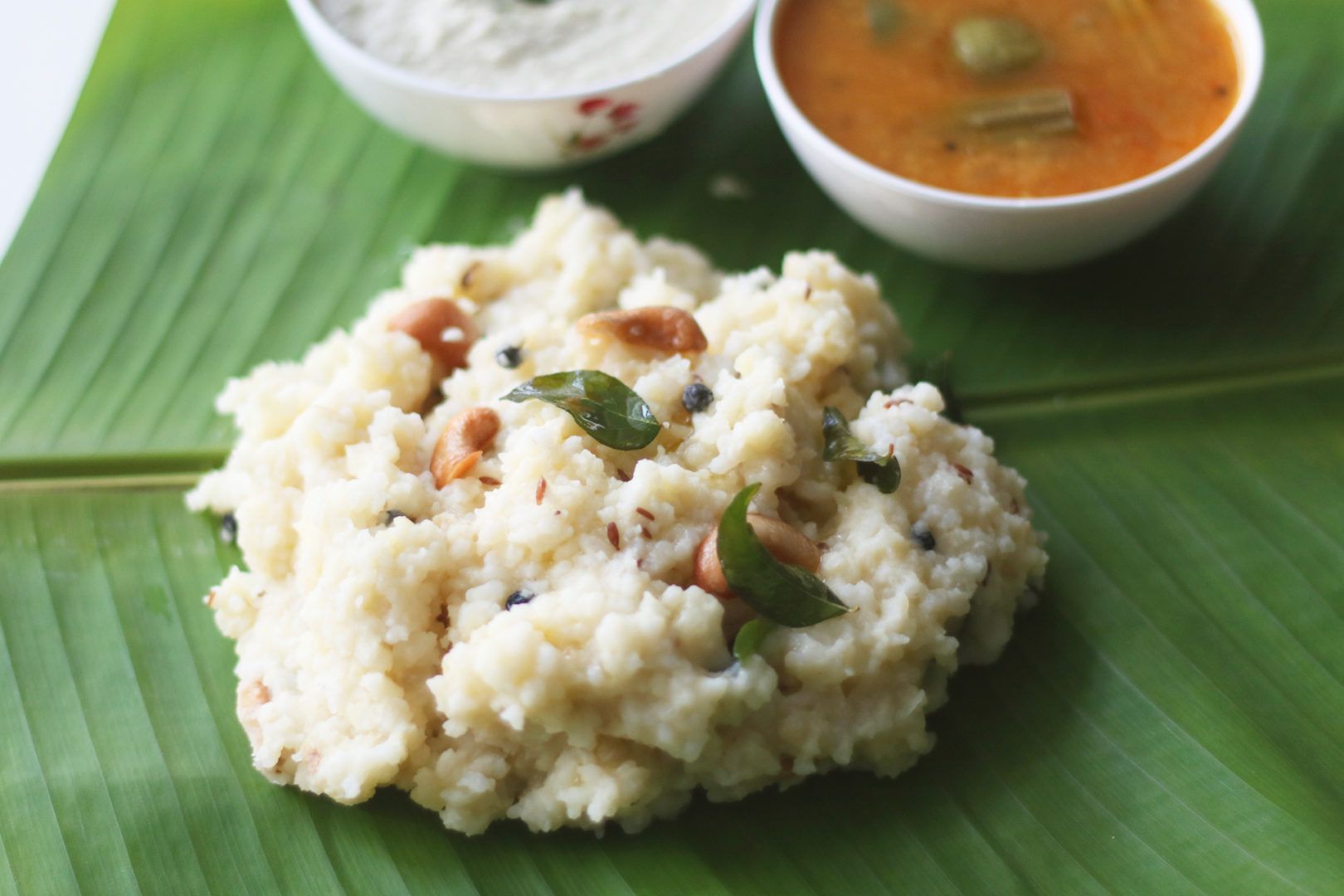
Ven Pongal
Serves 3
Prep Time 00:05
Cook Time 00:15
Total Time 00:20
Ingredients
- 1 cup raw rice
- 1/2 cup moong dal / pasi paruppu
- 1 tsp ghee
- 4 cups of water
- 2 to 3 tbsp ghee
- 10 to 15 cashews
- 1&1/2 tsp whole black pepper corns
- 1 tsp cumin seeds
- 1/4 tsp asafoetida
- 1 tsp grated ginger
- few curry leaves
- salt as needed (I added 1 tsp)
How to cook rice and dal
- Wash the rice and dal together a couple of times with water and drain very well and keep it aside in a separate bowl.
- Meanwhile, heat a pressure pan or a cooker with 1 tsp of ghee over medium heat.
- When the ghee melts, roast the rice and dal until a nice aroma comes. No need to brown them.
- Then add 4 cups of water and salt, and pressure cook it for 4 whistles.
- After 4 whistles, switch off the heat and wait until the pressure gets released by itself.
- Then open the lid and mash it well.
How to make ven pongal
- Meanwhile, heat a small pan with 2 to 3 tbsp of ghee, over low heat.
- When the ghee melts, fry the peppercorns until spluttering.
- Further, add cumin seeds, grated ginger, curry leaves and asafoetida one by one.
- Finally, add cashews and fry until they turn into golden brown.
- Switch off the heat, and pour this entire tempering to the mashed rice and dal mixture and mix well until they are combined.
- Remove from the heat and cover with the lid and keep the ven pongal aside for 5 mins. Because this step allows the tempering flavors to infuse with the pongal and it enhances the aroma.
- Then remove the lid and serve ven pongal hot with sambar or coconut chutney.
- By Santhi Therese The Indian Claypot
- https://theindianclaypot.com/
